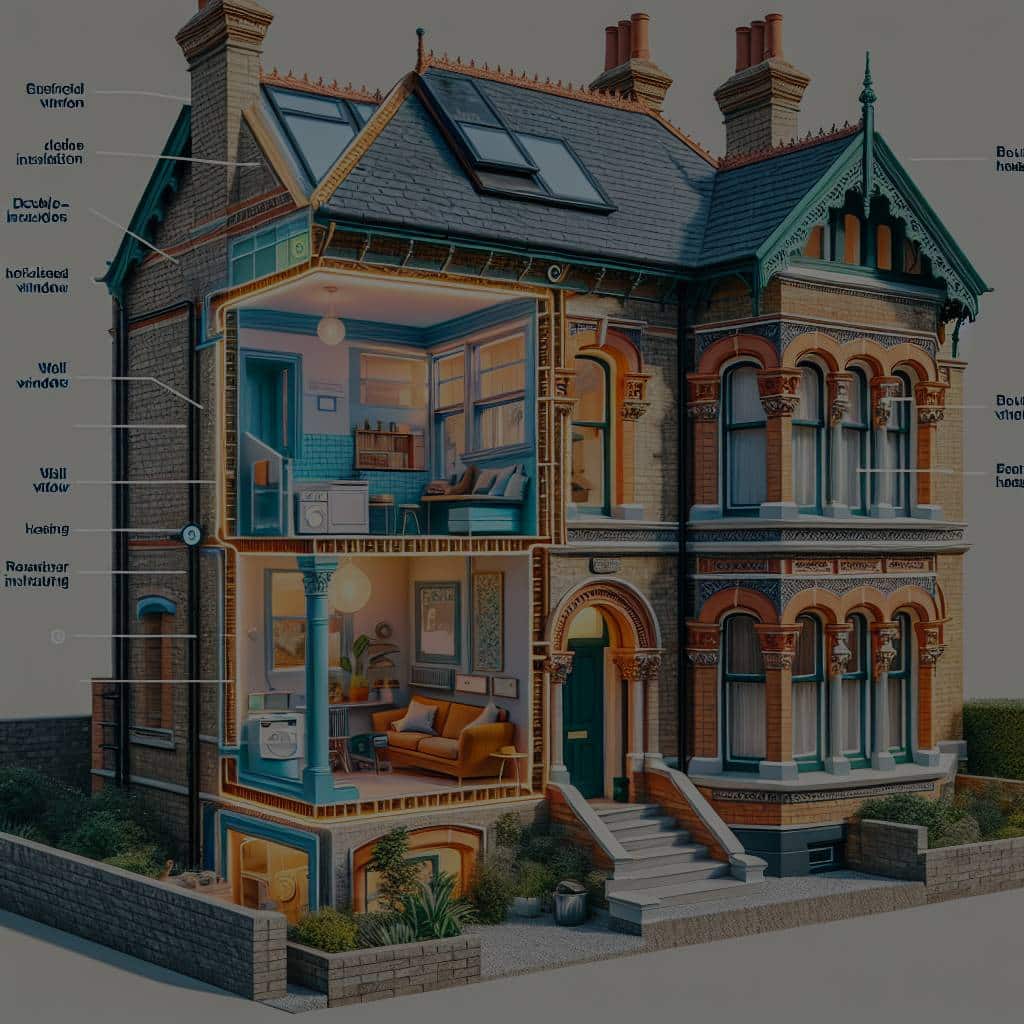Victorian homes, with their distinctive architecture and undeniable charm, are often a labor of love for homeowners. From their high ceilings and intricate woodwork to their ornate fireplaces and large windows, these properties are rich in heritage and historical appeal. However, these architectural novelties can also mean that such buildings are less energy efficient than their modern counterparts. This article aims to explore some of the best practices for retrofitting Victorian homes to improve their energy efficiency, focusing on aspects such as insulation, windows, heating and air systems, and preservation of historic features.
Please note: while this article provides general advice on retrofitting Victorian homes, it’s always important to consult with a professional to ensure any changes comply with local building regulations and preservation guidelines.
Also read : How to Navigate the UK’s Help to Buy Scheme for First-Time Homebuyers?
Retrofitting Insulation in Victorian Buildings
Insulating a Victorian home poses unique challenges due to the historic building techniques and materials used. However, proper insulation is essential to improve its energy efficiency and reduce heating consumption.
Insulation can be retrofitted in various areas in a Victorian house, including the loft, walls, and floors. Loft insulation is perhaps the easiest and most cost-effective solution. Victorian homes typically have accessible loft spaces that can be filled with insulation materials like mineral wool or foam boards.
In parallel : How Can Real Estate Agents Leverage Augmented Reality for Remote Viewings?
For wall insulation, you might consider internal or external solutions. Internal insulation, while less disruptive, tends to reduce the internal floor area. On the other hand, external insulation can alter the building’s exterior aesthetics, which might not be desirable in preserving a property’s historical appeal.
Insulating floors can also help minimize heat loss, especially in homes with original wooden floorboards. This can involve lifting the floorboards and laying mineral wool insulation supported by netting between the joists.
Energy-Efficient Windows for Historic Homes
Victorian homes often feature large, single-glazed windows that let in plenty of light but can also contribute to significant heat loss. Therefore, improving the energy efficiency of these windows is a crucial aspect of retrofitting.
One effective solution is to install secondary glazing. This involves fitting a fully independent internal window to existing single-glazed windows. It’s a popular option for historical buildings as it offers improved thermal performance without altering the original windows.
Another solution is to use heavy curtains or thermal blinds, which can provide additional insulation. Despite not being as effective as double glazing or secondary glazing, they can still make a noticeable difference in heat retention.
Heating and Air Systems in Heritage Buildings
Victorian homes were not built with modern heating and air systems in mind. Consequently, retrofitting these systems can be an intricate process that requires a delicate balance between improving energy efficiency and preserving historical features.
An efficient heating system for a Victorian home could be a condensing boiler, which has a much higher efficiency rate than old, non-condensing models. You could also consider installing underfloor heating, especially when renovating or insulating floors.
As for air systems, a whole-house ventilation system with heat recovery (MVHR) could be an efficient option. It provides fresh air and improved climate control, while also recovering heat from extracted air.
Sustainable Practices in Retrofitting Historic Buildings
While retrofitting your Victorian home for energy efficiency, it’s crucial to keep the principles of sustainable preservation in mind. This involves minimizing the impact on the original building fabric and features, using materials that are compatible with the existing ones, and where possible, choosing options that can be reversed in the future.
Reusing and repairing original materials and features where possible is another sustainable practice. This could involve repairing existing windows and doors, repointing brickwork, or carefully removing, restoring, and reusing original features like fireplaces, cornices, and skirtings.
Additionally, using locally sourced, sustainable materials for any new elements can help reduce the environmental impact of the retrofitting process.
The Role of Renewable Energy Systems in Retrofits
Incorporating renewable energy systems can further enhance the energy efficiency of a Victorian home. Solar panels, for instance, can provide a sustainable source of electricity and hot water. While the aesthetics of solar panels might not be in keeping with the traditional appearance of a Victorian home, they can often be placed out of sight on rear-facing roofs or ground-mounted in gardens.
Heat pumps are another renewable technology that can be considered. Ground-source or air-source heat pumps can provide an efficient source of heating and cooling, although they may require significant space and investment.
Remember, the goal of retrofitting should not only be about achieving energy efficiency but also about maintaining the character and heritage of your Victorian home. Balancing these aspects can ensure your house remains a testament to history while being a comfortable, efficient, and sustainable place to live.
Keep in mind: every home is unique. What works for one might not work for another. Always seek professional advice before embarking on any retrofitting work.
The Integration of HVAC Systems for Improving Energy Efficiency in Historic Buildings
Ancient architectural designs did not incorporate the use of HVAC systems, which are now integral in maintaining a comfortable living environment. Retrofitting Victorian homes with modern heating, ventilation, and air conditioning (HVAC) systems is therefore a sensitive task requiring a balance between preserving historical integrity and enhancing functionality.
The large, high-ceilinged rooms found in Victorian homes can pose a challenge when installing HVAC systems. However, with the right strategy and equipment, it is possible to achieve improved energy performance without compromising the aesthetic appeal of the home.
A high-efficiency condensing boiler can be an excellent option for heating as they are markedly more efficient than older, non-condensing models. Their compact design allows for subtle installation, maintaining the home’s original appearance.
Underfloor heating is another option when renovating or insulating floors, offering effective heating without the need for visible radiators or heaters.
As for ventilation, consider installing a whole-house ventilation system with heat recovery (MVHR). This system provides fresh air, improves climate control, and concurrently recovers heat from extracted air, thus contributing to energy saving.
Remember, the objective is to create an energy-efficient home that still retains its unique historical charm.
The Role of Renewable Energy in Retrofitting Historic Homes
In the quest for energy efficiency, renewable energy systems are a game-changer, and their integration in retrofitting historic buildings plays a critical role. Solar panels and heat pumps are two renewable energy technologies that can significantly reduce energy consumption and environmental impact.
Solar panels generate electricity using the sun’s energy, providing a sustainable source of power and hot water. The visual impact of solar panels on the building’s exterior may be a concern, but they can often be mounted in less conspicuous places such as rear-facing roofs or ground-mounted in gardens.
Heat pumps, either ground-source or air-source, offer a renewable source of heating and cooling. While they require a significant initial investment and space, their long-term energy savings make them a worthwhile consideration.
In utilizing renewable energy, Victorian homes can achieve modern energy efficiency standards while reducing their carbon footprint. The key takeaway here is that fitting renewable energy systems should be done judiciously to ensure that the cultural heritage of the historic building is not compromised.
In Conclusion
Retrofitting Victorian homes for energy efficiency presents unique challenges due to their historic character. However, with careful planning, the use of sustainable practices, and the integration of modern technology, it’s possible to improve energy performance while preserving their distinctive charm.
Key considerations include proper insulation, enhancing window energy efficiency, integrating modern HVAC systems, and integrating renewable energy systems. All of these elements need to be carefully balanced to achieve the dual aim of energy efficiency and historic preservation.
Remember, every home is unique, and retrofitting solutions must be customized to suit each specific property. It’s always crucial to consult with professionals who understand both energy efficiency and the importance of preserving our cultural heritage. Retrofitting Victorian homes is not just about saving energy; it’s about maintaining a connection to our past while embracing a sustainable future.
Remember: retrofitting should not be a compromise between energy efficiency and preserving cultural heritage. It should be a harmonious blend of both. Always seek professional advice before embarking on any retrofitting work.






